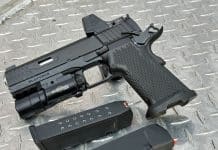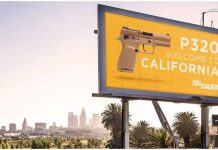[dcs_img_center
framed=”no” w=”600″ h=”400″]
http://gunsandtactics.wpengine.com/wp-content/uploads/2012/12/mr-1.jpg
[/dcs_img_center]
[dcs_post_top]
[dcs_fancy_header color=”#000000″ fweight=”bold”]The shooter to the right of me is a veteran SWAT and ERT officer. The shooter to the left is a gentleman that just likes shooting and is looking to hone his skills. One more down the line to my left is a portly police officer wearing a T-Shirt with a tactical stack of bad-asses on the back…he is getting some extra training during his off time.[/dcs_fancy_header]
[dcs_thinspliter size=”medium”]
There are about 24 of us getting ready for a two day shooting package put on by a former U.S. Army Delta Operator.
Shooters Ready? Begin firing when you are ready at your own pace.
Our course of fire is a simple one. There are three stages of slow fire at varying yard lines at your own pace and then two stages of fire that are timed. As we move up to the closer yard lines, shooters can start seeing their targets and see where they went wrong during the previous stages. Everyone checks the target of the person shooting next to them to see where they stand. Everything is a competition even when it is not. I check my target and am happy with what I see. I look right and am about on par or slightly better than the SWAT veteran. I look left and see the same results. I look one more target down the line to the left and wonder if that guy was throwing his rounds at the target from the 25 yard line instead of shooting them. Tactical Stack Shirt Guy, the police officer, is completely out of his element.
For far too long training has been dumbed down to standards that are acceptable. Individuals that carry firearms for their profession shouldn’t be acceptable people, they should be exceptional. Most entities that set standards for their gun-toting professionals whether it be local or federal police, military units, private security companies, etc. are setting their sights far too low (pun intended). If you shoot a qualification then look left and right and everyone is passing with flying colors or are above the standard, something is wrong. Each and every one of you has shot next to someone that you feel uncomfortable around but they consistently pass the ‘qual’. There will always be a disparity of skills, but that line needs to be thin.
Standard qualifications seem to be set largely by rounding down skill sets instead of up. They typically are geared toward the lowest common denominator. The problem with the standard qualification is that it may be the only time that quarter, half, or year that the individual being tested will be able to shoot. It is the same qualification that he shot last time, and he knows how the course of fire will go again. It does not require thought or effort. All the shooter has to do is stand there, wait for everyone else to finish, and walk toward the next firing line when the Range Officer says so.
I’m not saying standards shouldn’t be set, I’m saying they are far too low. Everyone in a carrying profession should be able to draw and fire a firearm accurately and effectively in a sterile situation. What happens when the shooter is presented with a situation that is stressful? Will that person buckle under the pressure, will he freeze and give up? The previous two questions should be answered in any agency qualification.
Special Units have the resources and money to train differently than your “average Joes”. This needs to change as well. An everyday “Beat Cop” is more likely to be involved in a dangerous situation on a daily basis than a specialized unit. He needs the same individual training afforded to specialized groups to mitigate any threats he may encounter.
Qualification day should not end when everyone is done shooting their piece of paper from behind a firing line. That is just step one. The second step needs to be a course of fire that is stressful and requires shooters to exert themselves in some way. They need to be shooting and moving, taking cover, reloading under pressure, and put their body in a state where they lose a portion of their fine motor skills. The qualification should provide the shooter with shoot vs. no shoot targets and scenarios. If there is a standardized duty gear requirement that states the shooter must carry less than lethal considerations, those items should be used OR CONSIDERED during the qualification course of fire. When the professional carrying a firearm is in a situation where he or she must use it, it will more than likely not be in an environment with a stationary target and no cover and concealment features.
Firearm carrying professionals need to get out of the mindset of training to a course of fire. If you have a qualification coming up and you go to the range or your back yard and shoot that course of fire, you aren’t improving anything. You are training to a standard that is far too low and putting a ceiling on your ability. Take yourself out of your comfort zone and do something to put stress on your body and find your fundamental faults. Talk to your training coordinator and find open range times, shoot on your own, do some dry fire practice at home. Your life and the lives of others around you depend on your abilities. Why would you want to half-ass it?
[dcs_darkspliter size=”medium”]
[dcs_img_left url=”http://www.mitigatedthreat.com/” target=”_blank”
framed=”no” w=”150″ h=”174″]
http://gunsandtactics.wpengine.com/wp-content/uploads/2012/12/mr.png
[/dcs_img_left]
James “Lester” Norris has 14 years of security experience ranging from Critical Infrastructure Protection & Disaster Preparedness for Intelligence Community assets to personal protection in High Threat Environments. He is currently a Team Leader/Unit Support Coordinator in southern Iraq for a private security company and recently founded Mitigated Threat, LLC.
[dcs_darkspliter size=”medium”]
[dcs_post_bottom]
[dcs_related_posts]












